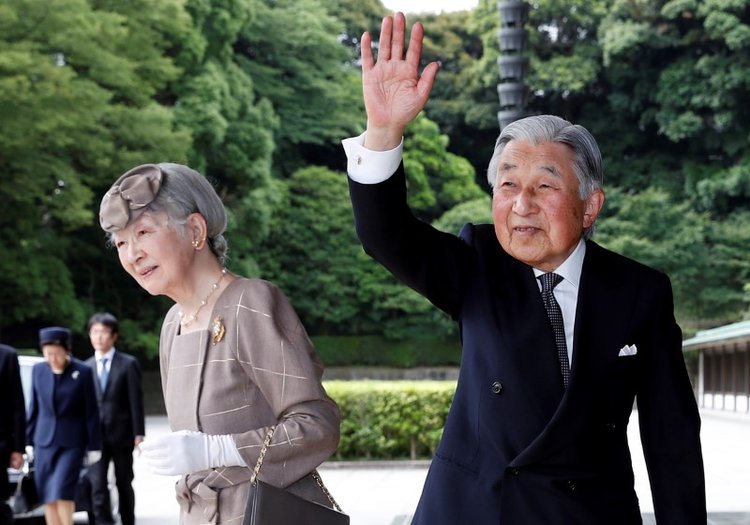The Emperor who pushed imperial boundaries

On Tuesday, Emperor Akihito will abdicate the Chrysanthemum Throne — the oldest continuous hereditary monarchy in the world — becoming the first Japanese monarch in modern history to do so. His son, Crown Prince Naruhito, 59, will be inaugurated as the 126th emperor the next day, ushering in the Reiwa era.The much-loved Emperor Akihito will be remembered for connecting with his public in a way that no other Japanese monarch has done and expressing “deep remorse” for the country’s actions during World War II.After having heart surgery and overcoming prostate cancer in recent years, the monarch cited health reasons for stepping down.”I am worried that it may become difficult for me to carry out my duties as the symbol of the state with my whole being, as I have done until now,” the soft-spoken Emperor said in 2016, in his second TV speech in three decades.It was seen as a plea to Japan’s lawmakers to change the law to allow him to retire. The following year, they did. “It won attention and respect from the people, who recognized the emperor actually had a will of his own,” said Hitomi Tonomura, a historian at University of Michigan’s Center for Japanese Studies. It was a fitting final move for a monarch who had often broken with tradition. He was also the first Japanese Emperor to marry a commoner, speak to his subjects live on television and to be hands-on in raising his children. A child of a deityWhen the Emperor was born in 1933, Japan was a very different place. War was brewing and his father, Emperor Hirohito, was revered as a human deity. In 1937, Japanese troops invaded Nanjing — then the capital of the Republic of China — killing around 300,000 Chinese in a weeks-long spree following the Japanese occupation, according to Chinese estimates. Japan has disputed the scale of the massacre.In 1940, Japan officially entered World War II on the side of Germany and Italy. The war years remain a controversial period in the nation’s history. As many as 200,000 women, mainly Korean, were forced into sex slavery by Japanese soldiers during WWII, according to a United Nations report. Japan has apologized and says the issue is resolved, but South Korea has demanded a more formal apology and reparations. When Emperor Hirohito made a radio address surrendering in 1945, most Japanese people had never heard his voice before, despite him having been in power already for nearly 20 years. After the war, Japan was occupied by the United States. The new constitution banned the Imperial family from engaging in politics and Emperor Hirohito renounced his divine status. The emperors were no longer gods — they were humans.Healing the woundsIn 1989, Emperor Akihito, was handed a country still dealing with the wounds of war. His reign has been called the Heisei era, which means “achieving peace” — and it has proved to be a fitting name.In May 1990, just over a year after he came to the throne, Emperor Akihito hosted then-South Korean President Roh Tae-woo at a state banquet where he made waves by admitting responsibility for Japan’s wartime aggressions. “I think of the sufferings your people underwent during this unfortunate period, which was brought about by my country, and cannot but feel the deepest regret,” he said.In 1992, the Emperor became the first Japanese monarch to visit China, where he said he felt a “deep sadness” for the “unfortunate period in which my country inflicted great suffering on the people of China.”He has also made several trips to Okinawa, where about 110,000 Japanese troops and 100,000 civilians lost their lives in the name of Emperor Hirohito. Anti-imperialist and anti-US sentiment ran deep on the small southern islands. During a 1975 trip, young radicals threw a fire bomb at the then-crown prince. The Emperor’s conciliatory sentiments about Japan’s wartime past contrast with that of Prime Minister Shinzo Abe, who has suggested that future generations should not have to keep apologizing for Japan’s past. Abe has also ignited criticism from China and South Korea in the past by visiting the Yasukuni Shrine in Tokyo, a controversial memorial site that includes names of convicted Japanese war criminals. Abe hasn’t visited the shrine since 2013, although earlier this year he sent it a ritual offering.”The Emperor has contributed more than all of Japan’s prime ministers combined in advancing reconciliation,” said Jeremy Yellen, a historian of modern Japan at Chinese University of Hong Kong. “These efforts to restore dignity to Japan’s victims has also helped the nation regain a dignity that remains imperiled by revisionists.”People’s emperorThroughout his three-decade rule, Emperor Akihito has embraced a more “normal” life.For a start, he became the first Emperor to marry a commoner. The Emperor met Empress Michiko in 1957 during tennis match in the scenic mountain town of Karuizawa. After they married, the couple often returned to the place where they met.When Emperor Akihito was a child, he was separated from his parents and raised and educated by chamberlains and tutors. But when the new royal couple had their three children, Naruhito, Fumihito and Sayako Kuroda, they declined hired help, instead raising the children themselves — even reportedly making them pack their own school lunches. In his spare time, the Emperor published scientific papers on raccoon dogs, after studying their excrement, which he had collected from the Imperial grounds, and compiled research on goby fish — a species of goby is named after him.But it was in 2011, as the country reeled from the fatal earthquake and tsunami that saw more than 20,000 people die or go missing, that Akihito truly cemented his reputation as a people’s Emperor. The Emperor made an unprecedented televised address — the first time any Japanese Emperor had spoken to the public on TV. “I truly hope the victims of the disaster never give up hope, take care of themselves and live strong for tomorrow,” he said.’);$vidEndSlate.removeClass(‘video__end-slate–inactive’).addClass(‘video__end-slate–active’);}};CNN.autoPlayVideoExist = (CNN.autoPlayVideoExist === true) ? true : false;var configObj = {thumb: ‘none’,video: ‘world/2019/04/29/japan-emperor-succession-crisis-ripley-pkg-vpx.cnn’,width: ‘100%’,height: ‘100%’,section: ‘international’,profile: ‘expansion’,network: ‘cnn’,markupId: ‘body-text_42’,theoplayer: {allowNativeFullscreen: true},adsection: ‘const-article-inpage’,frameWidth: ‘100%’,frameHeight: ‘100%’,posterImageOverride: {“mini”:{“width”:220,”type”:”jpg”,”uri”:”//cdn.cnn.com/cnnnext/dam/assets/190429171030-japan-imperial-palace-1135906484-small-169.jpg”,”height”:124},”xsmall”:{“width”:307,”type”:”jpg”,”uri”:”//cdn.cnn.com/cnnnext/dam/assets/190429171030-japan-imperial-palace-1135906484-medium-plus-169.jpg”,”height”:173},”small”:{“width”:460,”type”:”jpg”,”uri”:”//cdn.cnn.com/cnnnext/dam/assets/190429171030-japan-imperial-palace-1135906484-large-169.jpg”,”height”:259},”medium”:{“width”:780,”type”:”jpg”,”uri”:”//cdn.cnn.com/cnnnext/dam/assets/190429171030-japan-imperial-palace-1135906484-exlarge-169.jpg”,”height”:438},”large”:{“width”:1100,”type”:”jpg”,”uri”:”//cdn.cnn.com/cnnnext/dam/assets/190429171030-japan-imperial-palace-1135906484-super-169.jpg”,”height”:619},”full16x9″:{“width”:1600,”type”:”jpg”,”uri”:”//cdn.cnn.com/cnnnext/dam/assets/190429171030-japan-imperial-palace-1135906484-full-169.jpg”,”height”:900},”mini1x1″:{“width”:120,”type”:”jpg”,”uri”:”//cdn.cnn.com/cnnnext/dam/assets/190429171030-japan-imperial-palace-1135906484-small-11.jpg”,”height”:120}}},autoStartVideo = false,isVideoReplayClicked = false,callbackObj,containerEl,currentVideoCollection = [],currentVideoCollectionId = ”,isLivePlayer = false,mediaMetadataCallbacks,mobilePinnedView = null,moveToNextTimeout,mutePlayerEnabled = false,nextVideoId = ”,nextVideoUrl = ”,turnOnFlashMessaging = false,videoPinner,videoEndSlateImpl;if (CNN.autoPlayVideoExist === false) {autoStartVideo = false;if (autoStartVideo === true) {if (turnOnFlashMessaging === true) {autoStartVideo = false;containerEl = jQuery(document.getElementById(configObj.markupId));CNN.VideoPlayer.showFlashSlate(containerEl);} else {CNN.autoPlayVideoExist = true;}}}configObj.autostart = CNN.Features.enableAutoplayBlock ? false : autoStartVideo;CNN.VideoPlayer.setPlayerProperties(configObj.markupId, autoStartVideo, isLivePlayer, isVideoReplayClicked, mutePlayerEnabled);CNN.VideoPlayer.setFirstVideoInCollection(currentVideoCollection, configObj.markupId);videoEndSlateImpl = new CNN.VideoEndSlate(‘body-text_42’);function findNextVideo(currentVideoId) {var i,vidObj;if (currentVideoId && jQuery.isArray(currentVideoCollection) && currentVideoCollection.length > 0) {for (i = 0; i 0) {videoEndSlateImpl.showEndSlateForContainer();if (mobilePinnedView) {mobilePinnedView.disable();}}}}callbackObj = {onPlayerReady: function (containerId) {var playerInstance,containerClassId = ‘#’ + containerId;CNN.VideoPlayer.handleInitialExpandableVideoState(containerId);CNN.VideoPlayer.handleAdOnCVPVisibilityChange(containerId, CNN.pageVis.isDocumentVisible());if (CNN.Features.enableMobileWebFloatingPlayer &&Modernizr &&(Modernizr.phone || Modernizr.mobile || Modernizr.tablet) &&CNN.VideoPlayer.getLibraryName(containerId) === ‘fave’ &&jQuery(containerClassId).parents(‘.js-pg-rail-tall__head’).length > 0 &&CNN.contentModel.pageType === ‘article’) {playerInstance = FAVE.player.getInstance(containerId);mobilePinnedView = new CNN.MobilePinnedView({element: jQuery(containerClassId),enabled: false,transition: CNN.MobileWebFloatingPlayer.transition,onPin: function () {playerInstance.hideUI();},onUnpin: function () {playerInstance.showUI();},onPlayerClick: function () {if (mobilePinnedView) {playerInstance.enterFullscreen();playerInstance.showUI();}},onDismiss: function() {CNN.Videx.mobile.pinnedPlayer.disable();playerInstance.pause();}});/* Storing pinned view on CNN.Videx.mobile.pinnedPlayer So that all players can see the single pinned player */CNN.Videx = CNN.Videx || {};CNN.Videx.mobile = CNN.Videx.mobile || {};CNN.Videx.mobile.pinnedPlayer = mobilePinnedView;}if (Modernizr && !Modernizr.phone && !Modernizr.mobile && !Modernizr.tablet) {if (jQuery(containerClassId).parents(‘.js-pg-rail-tall__head’).length) {videoPinner = new CNN.VideoPinner(containerClassId);videoPinner.init();} else {CNN.VideoPlayer.hideThumbnail(containerId);}}},onContentEntryLoad: function(containerId, playerId, contentid, isQueue) {CNN.VideoPlayer.showSpinner(containerId);},onContentPause: function (containerId, playerId, videoId, paused) {if (mobilePinnedView) {CNN.VideoPlayer.handleMobilePinnedPlayerStates(containerId, paused);}},onContentMetadata: function (containerId, playerId, metadata, contentId, duration, width, height) {var endSlateLen = jQuery(document.getElementById(containerId)).parent().find(‘.js-video__end-slate’).eq(0).length;CNN.VideoSourceUtils.updateSource(containerId, metadata);if (endSlateLen > 0) {videoEndSlateImpl.fetchAndShowRecommendedVideos(metadata);}},onAdPlay: function (containerId, cvpId, token, mode, id, duration, blockId, adType) {/* Dismissing the pinnedPlayer if another video players plays an Ad */CNN.VideoPlayer.dismissMobilePinnedPlayer(containerId);clearTimeout(moveToNextTimeout);CNN.VideoPlayer.hideSpinner(containerId);if (Modernizr && !Modernizr.phone && !Modernizr.mobile && !Modernizr.tablet) {if (typeof videoPinner !== ‘undefined’ && videoPinner !== null) {videoPinner.setIsPlaying(true);videoPinner.animateDown();}}},onAdPause: function (containerId, playerId, token, mode, id, duration, blockId, adType, instance, isAdPause) {if (mobilePinnedView) {CNN.VideoPlayer.handleMobilePinnedPlayerStates(containerId, isAdPause);}},onTrackingFullscreen: function (containerId, PlayerId, dataObj) {CNN.VideoPlayer.handleFullscreenChange(containerId, dataObj);if (mobilePinnedView &&typeof dataObj === ‘object’ &&FAVE.Utils.os === ‘iOS’ && !dataObj.fullscreen) {jQuery(document).scrollTop(mobilePinnedView.getScrollPosition());playerInstance.hideUI();}},onContentPlay: function (containerId, cvpId, event) {var playerInstance,prevVideoId;if (CNN.companion && typeof CNN.companion.updateCompanionLayout === ‘function’) {CNN.companion.updateCompanionLayout(‘restoreEpicAds’);}clearTimeout(moveToNextTimeout);CNN.VideoPlayer.hideSpinner(containerId);if (Modernizr && !Modernizr.phone && !Modernizr.mobile && !Modernizr.tablet) {if (typeof videoPinner !== ‘undefined’ && videoPinner !== null) {videoPinner.setIsPlaying(true);videoPinner.animateDown();}}},onContentReplayRequest: function (containerId, cvpId, contentId) {if (Modernizr && !Modernizr.phone && !Modernizr.mobile && !Modernizr.tablet) {if (typeof videoPinner !== ‘undefined’ && videoPinner !== null) {videoPinner.setIsPlaying(true);var $endSlate = jQuery(document.getElementById(containerId)).parent().find(‘.js-video__end-slate’).eq(0);if ($endSlate.length > 0) {$endSlate.removeClass(‘video__end-slate–active’).addClass(‘video__end-slate–inactive’);}}}},onContentBegin: function (containerId, cvpId, contentId) {if (mobilePinnedView) {mobilePinnedView.enable();}/* Dismissing the pinnedPlayer if another video players plays a video. */CNN.VideoPlayer.dismissMobilePinnedPlayer(containerId);CNN.VideoPlayer.mutePlayer(containerId);if (CNN.companion && typeof CNN.companion.updateCompanionLayout === ‘function’) {CNN.companion.updateCompanionLayout(‘removeEpicAds’);}CNN.VideoPlayer.hideSpinner(containerId);clearTimeout(moveToNextTimeout);CNN.VideoSourceUtils.clearSource(containerId);jQuery(document).triggerVideoContentStarted();},onContentComplete: function (containerId, cvpId, contentId) {if (CNN.companion && typeof CNN.companion.updateCompanionLayout === ‘function’) {CNN.companion.updateCompanionLayout(‘restoreFreewheel’);}navigateToNextVideo(contentId, containerId);},onContentEnd: function (containerId, cvpId, contentId) {if (Modernizr && !Modernizr.phone && !Modernizr.mobile && !Modernizr.tablet) {if (typeof videoPinner !== ‘undefined’ && videoPinner !== null) {videoPinner.setIsPlaying(false);}}},onCVPVisibilityChange: function (containerId, cvpId, visible) {CNN.VideoPlayer.handleAdOnCVPVisibilityChange(containerId, visible);}};if (typeof configObj.context !== ‘string’ || configObj.context.length 0) {configObj.adsection = window.ssid;}CNN.autoPlayVideoExist = (CNN.autoPlayVideoExist === true) ? true : false;CNN.VideoPlayer.getLibrary(configObj, callbackObj, isLivePlayer);});CNN.INJECTOR.scriptComplete(‘videodemanddust’);Akihito and Michiko traveled to disaster-hit areas, kneeling to talk to survivors face-to-face. “It was like a dream,” Fukushima evacuee Ayako Moriie said, describing meeting the royals in the school gymnasium where survivors were staying. “Even though they might be above the clouds where we normally can’t reach, it was comforting that they think the same as we do. His words gave us the strength to carry on.”Andrew Gordon, a leading scholar of modern Japanese history at Harvard University, said that Akihito’s actions had made the Imperial family more accessible. But he cautioned that compared to some monarchies in Europe, Japan’s was still a “very distant institution.” The incoming Naruhito’s name means “a man who will acquire heavenly virtues.” But the crown prince has shown no hint of harking back to the era of the demi-gods when he ascends to the Japanese throne on May 1. The crown prince studied at Oxford University and is passionate about environmental issues. Like his father, he has married a commoner, Masako Owada, who previously worked as a career diplomat. Those who know Naruhito describe him as “modest, charming and astute,” says Jeffrey Kingston, director of Asian Studies at Temple University in Japan. ]]]]>]]>Naruhito has also indicated that he will continue his father’s legacy of speaking out against revisionist history of WWII. “I myself did not experience the war,” he said on his 55th birthday in 2015. “But I think that it is important today, when memories of the war are fading, to look back humbly on the past and correctly pass on the tragic experiences and history Japan pursued from the generation which experienced the war to those without direct knowledge.”In February, the crown prince went further to explicitly say that he will continue his father’s legacy. “I want to earnestly fulfill my duties by always being close to the people, and sharing with them their joys and sorrows,” he said at a press conference.The challenge for Naruhito will be how to emerge from the shadow of his father and establish himself as a modern leader of Japan’s ancient monarchy.CNN’s Mohammed Elshamy contributed to this report from Atlanta. CNN’s Junko Ogura, Hidetaka Sato and Dan Campisi contributed to this report from Tokyo and Hong Kong.







